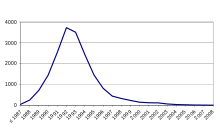Beef Bones Regulations 1997
| Statutory Instrument | ||
 Commencement 16 December 1997 | | |
| Text of the Beef Bones Regulations 1997 as in force today (including any amendments) within the United Kingdom, from legislation.gov.uk. | ||
|---|---|---|
The Beef Bones Regulations 1997 was a statutory instrument of the British government that limited the sale of beef on the bone. The regulations were implemented as a response to the United Kingdom BSE outbreak (mad cow disease) over fears that variant Creutzfeldt–Jakob disease in humans might be caused by the consumption of dorsal root ganglia, which lie near the bone. As well as beef on the bone, all beef-bone derived products were prohibited from sale. This had the effect of outlawing T-bone steaks, prime ribs and oxtail as well as some soups and stocks. Other aspects of the regulations dealt with the deboning of beef and the keeping of records in the food production industry. The restrictions on sales were lifted in December 1999 and the regulations as a whole were revoked in April 2008.
Background

The regulations were among 60 issued by the British
Regulations

The stated purpose of the regulations was "to protect public health and maintain confidence in beef and beef products".[3] They were a statutory instrument (SI) made under the powers granted by the Food Safety Act 1990, applied across Great Britain and came into force on 16 December 1997.[4][5] The Minister of Agriculture, Fisheries and Food at the time the regulations were implemented was Jack Cunningham.[6] While the regulations only extended to Great Britain, comparable restrictions were brought in for Northern Ireland as a statutory rule, the Beef Bones Regulations (Northern Ireland) 1997, under the powers in the Food Safety (Northern Ireland) Order 1991.[citation needed]
The regulations prohibited the sale of any beef on the bone (from animals aged 6 months or older) and restricted the use of beef bone material in food products for human consumption.[4][5] They also banned the deboning of beef anywhere except in a recognised food processing premises and created a responsibility for the operator of such premises to ensure that deboning was carried out in such a manner as to prevent contamination of food stuffs. The regulations also specified how beef bones should be stored and required food producers to keep records pertaining to the origin of their beef. The ban on the sale of beef on the bone came into force immediately, and food producers were granted a three-month period to implement the other aspects of the regulations.[5]
The regulations were imposed because of fears that previous practices risked contamination of foodstuffs by
There were protests against the ban, which some consumers saw as an over-reaction to the risk of vCJD infection by a paternalistic government, and the
Amendment and revocation
On 30 November 1999 the Minister of Agriculture, Fisheries and Food
Incidence of BSE continued to decline and the European Union ban on British beef exports was lifted on 1 May 2006.[15] The Beef Bones Regulations 1997 were revoked in April 2008. This led to an increase in the production of desinewed meat, recovered from beef bones, that was sold as mechanically separated meat. The Food Standards Agency banned this production in 2012.[16]
References
- ^ ISBN 978-0-8264-7620-3.
- ^ "Bovine spongiform encephalopathy". WHO. November 2002. Archived from the original on 18 December 2012. Retrieved 13 October 2020.
- ^ ISBN 978-1-4129-3356-8.
- ^ ISBN 978-0-85199-751-3.
- ^ a b c d "Title: Beef Bones Regulations". Agricultural Document Library, University of Hertfordshire. Department for Environment, Food and Rural Affairs. Archived from the original on 30 October 2020. Retrieved 13 October 2020.
- ^ "Parliamentary career for Lord Cunningham of Felling". UK Parliament. Archived from the original on 18 October 2020. Retrieved 13 October 2020.
- S2CID 144307500.
- ^ "Beef Bones Regulations 1997 (Hansard, 27 January 1998)". api.parliament.uk. 27 January 1998. Archived from the original on 17 October 2020. Retrieved 16 October 2020.
- ^ a b c d e f g h Meikle, James (1 December 1999). "Brown lifts beef on the bone ban". The Guardian. Archived from the original on 18 October 2020. Retrieved 13 October 2020.
- ISBN 978-1-4616-4385-2.
- ^ "Court castigates beef-on-bone ban". independent.ie. 22 April 1998. Archived from the original on 30 October 2020. Retrieved 14 October 2020.
- ^ The Edinburgh Law Review. 1998. p. 254.
- ^ Quinn, Joe (27 June 1998). "Judges reinforce beef on bone ban". independent.co.uk. Archived from the original on 30 October 2020. Retrieved 14 October 2020.
- ISBN 978-1-84113-207-5.
- ^ "End to 10-year British beef ban". BBC News. 3 May 2006. Archived from the original on 28 August 2021. Retrieved 13 October 2020.
- ISBN 978-0-215-04725-0. Archivedfrom the original on 15 December 2023. Retrieved 14 October 2020.
